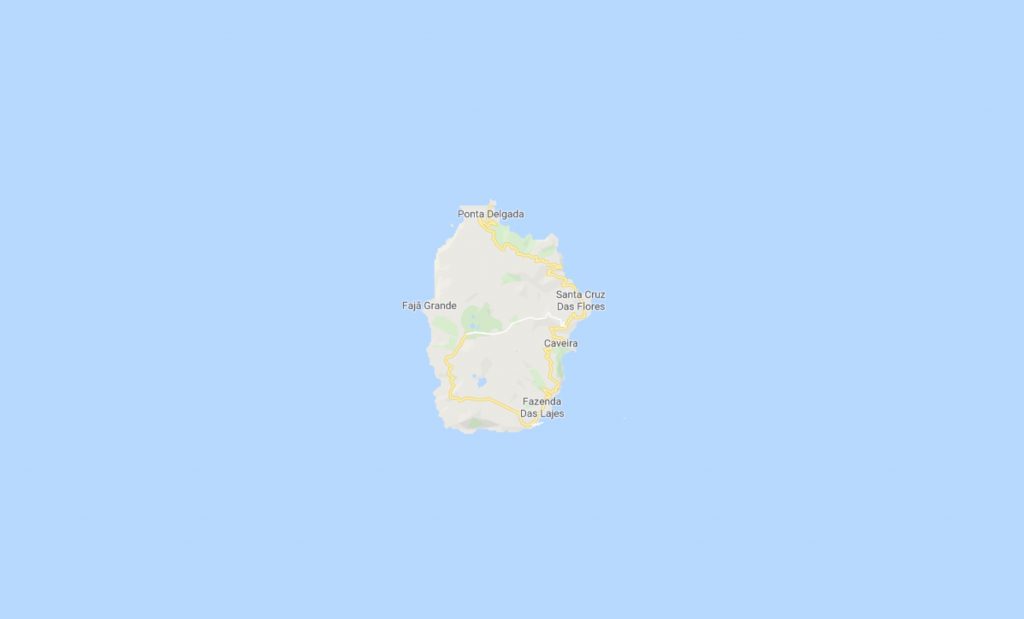
Flores Island – Azores – on Google Map
GEOGRAPHY
Flores Island, in the Azores is the westernmost point of the European continent. At 16.6 kilometers long and 12.2 kilometers at maximum width, with an area of 141.4 km2, it is the fourth by size amongst the 9 islands that compose the Azores Archipelago
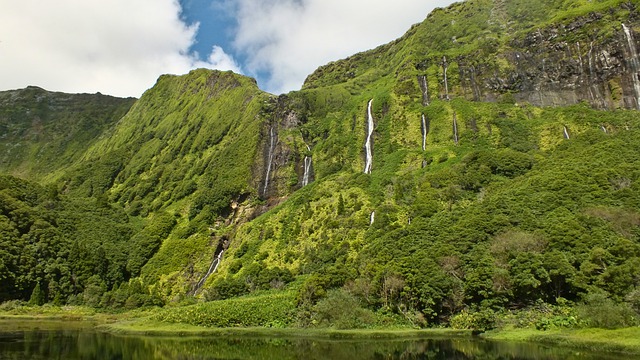
Flores is part of the western group of the Azores Islands, together with the island of Corvo, which is 17.9 kilometers away. Its highest point is located in Morro Alto (911 m.), At 39 ° 27’48 ’’ north latitude and 31 ° 13’13 ’’ west longitude. It is sparsely populated, with only about 4000 people living there permanently.
HISTORY
The Portuguese discovery of the present Western Group must have occurred around 1452. It is believed that Diogo de Teive was the navigator who discovered such a distant territory, and the name Flores is thought to be associated with the abundance of flowers recorded on the island in the decade of 1470
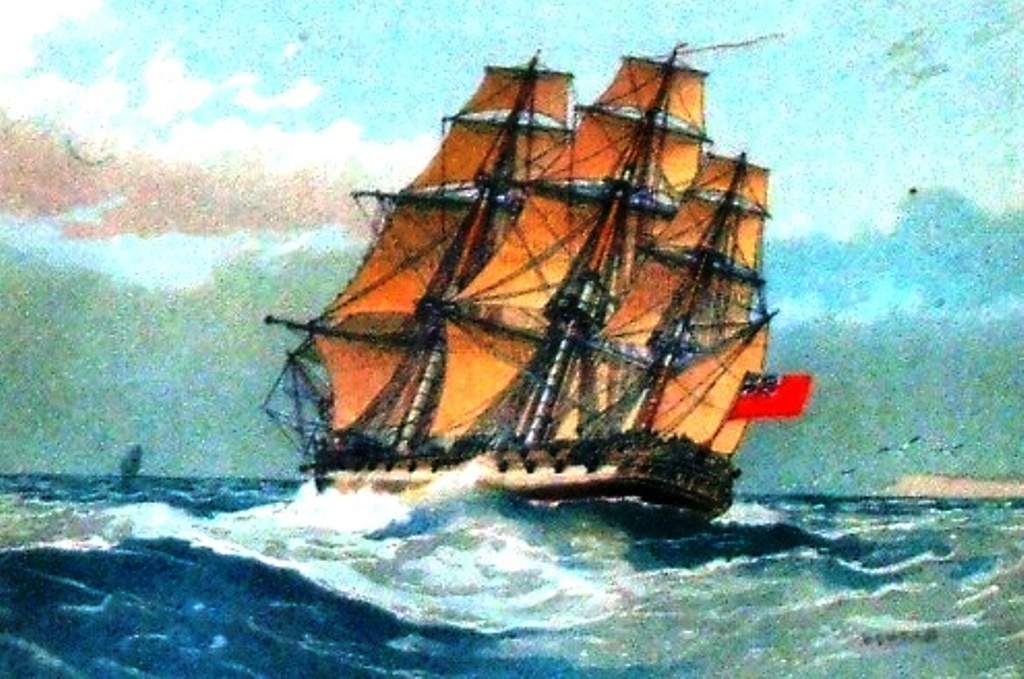
Population was not easy; moreover, the geographical peculiarity of the Western Group is reflected in its political configuration, since, unlike the other islands, Flores and Corvo constituted an individualized lordship that King D. Afonso V offered in 1453 to his uncle D. Afonso, duke of Bragança and count of Barcelos.
Even in Flores Island the first population efforts were Flemish, and in particular by Willem van der Haghen, who after initially settling in São Jorge, around 1480 decided to seek fortune in even more western areas. Either because he was disappointed with Flores’ economic potential, or because he couldn’t stand isolation from the rest of the archipelago, his experience was unsuccessful, and the Flemish returned to São Jorge. Abandoned for years, the territory had to wait until 1508 for a stable population to occur, this time thanks to the commitment of the captains of the Fonseca family. Although late, population growth began to consolidate. Lajes das Flores was declared a citizen in 1515, and Santa Cruz das Flores in 1548. From the end of the 16th century, at the hands of the Mascarenha, the development of Flores was even more incisive.As in most of the archipelago, the cultivation of cereals represented the economic basis for a couple of centuries, assisted by the breeding of sheep, the manufacture of cloth and fishing.
During the 16th and 17th centuries, the island lived quiet and isolated, but this condition was brought into question by the frequent and unwanted visits by the corsairs. Flores Island, the most western point in Europe, a highly important tactical position, was the strategic point of support given by the Crown to the ships of the Pacific and Indians. But the island was also guarded by pirates and pirates, who in turn happily awaited the passage of the Spanish galleons loaded with precious metals embarked in America, and Portuguese ships from the East.
The nineteenth-century writing of Lord Alfred Tennyson perpetuated in the poem The Revenge this remote time of adventure and naval boarding. “At Flores in the Azores Sir Richard Grenville lay”: thus begins the story of the heroic defeat of the ship commanded by the English corsair Sir Richard Grenville, beaten by a Spanish fleet. From the mid-eighteenth century, Flores became the port of the English and North American whaling armies, which landed there to supply and hire new members for their crews. This influence led to the organization of sperm whale hunting bases in both Lajes das Flores and Santa Cruz das Flores: the installations then built to proceed with the extraction of whale oil still exist.
The inauguration of the airport in 1972 and the construction of modern port installations have led to a greater integration of the Western Group into the Azores Archipelago. The tertiary sector is currently the engine of the island’s economy, occupying about 60% of the workforce, and tourism is also an increasingly significant field.
NATURE
THE PINK ISLAND
The undulating central volcanic massif conditions the whole landscape. On the plateau, cones with gently sloping slopes rise up or explode craters, with steep walls, which sometimes turned into lakes.
These are the features drawn by a nature that was once violent, but which today welcomes visitors with kindness. From the top of Morro Alto you can see an ocean of intense green, where the original laurisilva forest still lives. Streams flow among the luxuriant vegetation, while the waterfalls help to water a natural garden of colored flowers, in which the pink of azaleas and hydrangeas stands out.
VOLCANIC LANDSCAPES
The Flores Island landscape is characterized by craters, lakes and streams. The water of the streams flows indolently on the surface of the central plateau, but gains speed at the waterfalls or along extensive and deep valleys. Before jumping into the sea, it has enough strength to move the turbines of various hydroelectric plants.
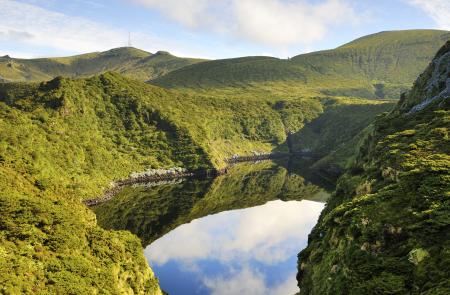
The island contains seven volcanic craters that have turned into beautiful lakes. Caldeira Rasa and Caldeira Funda, those further south, despite being very close to each other, have different altitudes. The luxuriant vegetation and the clusters of flowers that arise on the slopes form the natural scenery that surrounds them. Practically in the center of the island are the craters (called Caldeira Branca, Caldeira Seca, Caldeira Conprida and Caldeira Negra (or Funda), the latter 105 m deep. and with a special blue tone. Isolated from the others, the Caldeira da Lomba crater is surrounded by a small elevation and hydrangea bushes.
One of the most famous natural monuments of the Azores, the Rocha dos Bordões, consists of a set of large basalt columns. The prismatic disjunction resembles a giant pipe organ, and is located on top of an elevation. Coated here and there with moss, lichen and other vegetation, the basaltic stone has colors that vary during the day, seeming to urge a repeated return to these places.
Geological formations with a peculiar format are also found on Morro dos Frades, where some see in the stone silhouettes the figures of a friar and a nun. Even more symbolic, the islet of Monchique is the westernmost piece of land on the European continent: seen from Vigia da Ponta Negra, near the Albarnaz lighthouse, this black rock is the end point of Europe, but it can also be the preface discovering an island and an archipelago.The Fajã Grande – Fajãzinha area has one of the most beautiful Azorean coastal landscapes. Along the extensive green wall that borders it there are twenty imposing waterfalls, including that of Ribeira Grande, whose waters make a jump of 300 meters. At the base of the escarpment there are various permanent bodies of water, such as the Poço do Bacalhau (‘well of cod’) or the Poço da Alagoinha, also known as Lagoa dos Patos (‘lake of the ducks’). A walk to the escarpment allows you to admire closely the waterfalls and the scenery mounted by nature, which is an authentic invitation to contemplation and a refreshing bath. The dark gray of the rock, the lush green of the vegetation, the energetic white of the sea foam and the crystalline blue of the pool come together in a prodigious vision.
COAST
Countless islets, peaks, plains, coastal caves, prismatic disjunctions, waterfalls and valleys are some of the peculiarities of the Flores coast. Between the high cliffs of the southern coast, Fajã Nova, on the Ponta da Rocha Alta, and Fajã de Lopo Vaz can be reached on foot thanks to the path that runs alongside the cliff.
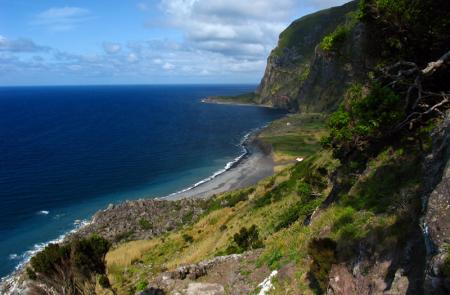
On the northern side of the island, the low and linear coastal cliff between Ponta Delgada and Ponta do Albarnaz allows access to the unthinkable reliefs of the north-east coast of Flores, crossed only by paths, such as the one that starts from the Albarnaz lighthouse and leads up to to Ponta da Fajã, a difficult journey but full of extraordinary panoramas.
The flat areas (fajãs) of Santa Cruz, Lajes and Fajã Grande are instead gently embraced by the sea, which wraps their low points of black lava and, on calm days, allows you to see shimmering and throbbing backdrops of life.
ATTRACTIONS
The grandeur and diversity of the Flores coastline justify a long boat trip. In fact, only from the sea can you see the Arch of Santa Cruz das Flores, or the islet Maria Vaz, or enter the 50-meter-long coastal cave called Gruta dos Enxaréus.
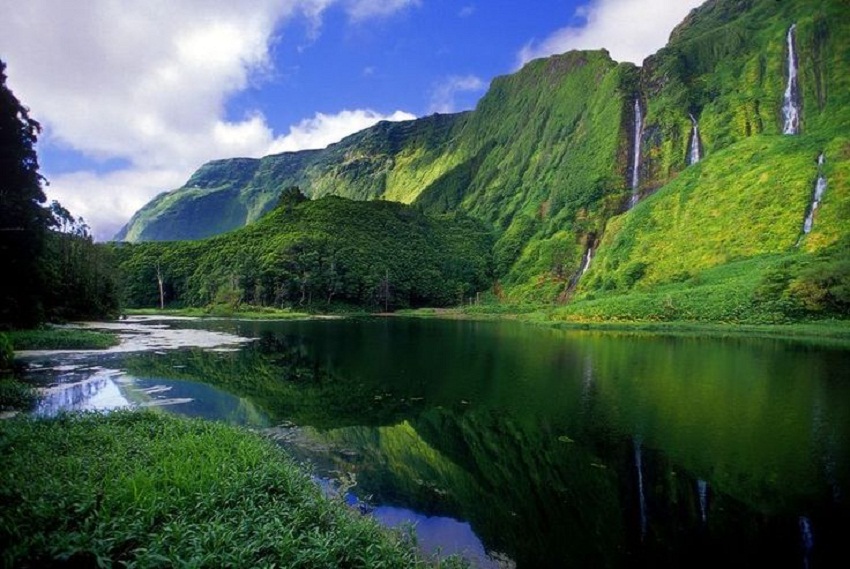
It is also possible to cross a stretch of sea and reach Corvo, using the services of the various operators who offer trips to discover the small island that can be seen on the horizon from the north-east coast of Flores. You can swim in the natural pools of Santa Cruz, on the beaches close to Lajes das Flores, or on the stony one of Fajã Grande, or in the pools of the feet of the waterfalls, as in Poço do Bacalhau and Ribeira Grande.
In Flores Island you can practice scuba diving and the observation of cetaceans, as well as you can fish from the rocks, in the sea or in the streams full of trout. On the ground, those who are licensed can hunt woodcocks and rabbits. The island is one of the best spots in the Azores for observing birds such as the ruler and blackcap, and is an authentic refuge for sedentary and migratory species, especially for those coming from the American continent.
Given the abundance of streams and waterfalls, canyoning is booming. There are dozens of places suitable for the practice of this modality, and there are special courses for those who have never tried this form of alliance between adrenaline and contact with nature.
HERITAGE AND CULTURE
ARCHITECTURE
Across the island, various churches stand out from the rest of the houses due to their size and the white of the walls, framed by the predominantly gray tone of the inevitable carved stone.
The church of Nossa Senhora de Lurdes, in Fazenda, of the twentieth century, is emblematic: built on an elevation, it can be seen from afar and, at the same time, serves as a observation point for the surrounding fields. From the viewpoint that meets on Fajãzinha you can observe the whole town, lost in the middle of a green plain.
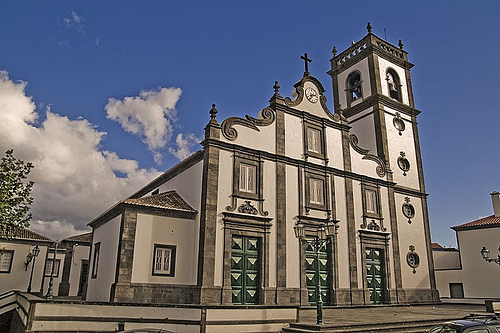
In Santa Cruz das Flores, the main church of Nossa Senhora da Conceição stands out for its grandiose facade, and the narrow streets of the town recall atmospheres of the past. The central Piazza Marquês do Pombal has a bright império (chapel dedicated to the cult of the Holy Spirit), and the descent towards the port allows you to discover other colors, thanks to the colors used on fishing boats. From the Monte das Cruzes viewpoint, these and other atmospheres can be captured and admired as a whole.
In Lajes das Flores, the church of Nossa Senhora do Rosário, built in the 18th century, is noteworthy, the facade of which was later covered with azulejos. From the atrium, framed by araucarias, you can see the port and a part of the town: and from here you can start to discover the impérios, the carved basalt stone houses and the bridge dating back to 1743 that crosses the stream called Ribeira dos Morros.
CULTURE
Installed in a part of the ancient Franciscan convent of Santa Cruz, the Flores Museum documents the islanders’ relations with the sea and the land. Particularly important are the collections of agricultural tools, scrimshaw and maritime tools, objects related to carpentry and iron working, as well as to the production of linen and wool fabrics. The collection of artifacts recovered from the Slavonian shipwreck, which sank off the coast of Flores in 1909, is very curious.
CRAFTS
Hydrangea marrow flowers are a delicate work that requires firm hands with great skill. The island’s artisan tradition also passes through fish scale flowers, objects made with shells, embroidery and lace. The wooden miniatures reproduce agricultural tools.
FESTIVITY
The Feast of the Emigrant – Festa Do Imigrante – is the tribute that the inhabitants of Flores pay to those who have left in search of a better life, but who return every year to visit their homeland. This year will take place from July 19th to 22nd.
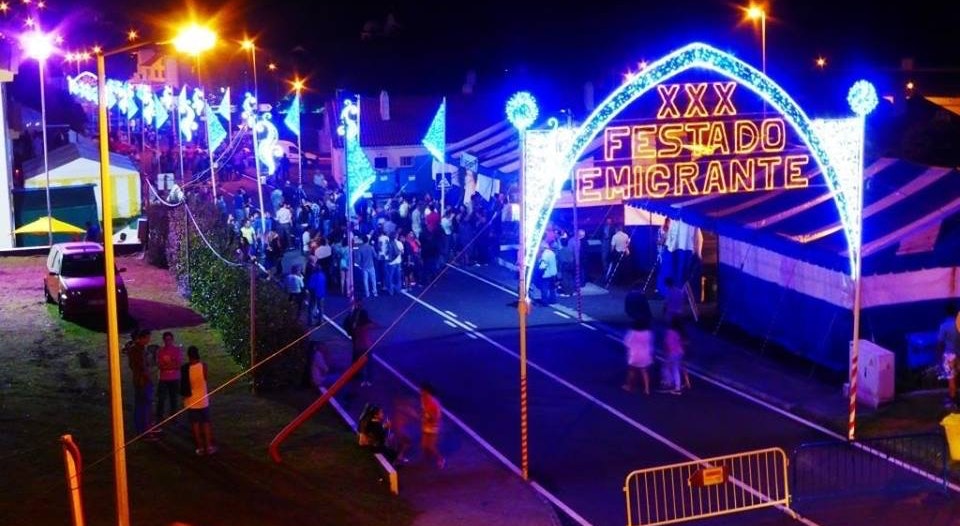
The popular celebrations, an opportunity to meet again with old friends, mark the calendar of the island during the month of July. Just before, on June 24, San Giovanni is celebrated. The devotion to the patron saint dates back to the colonists who came from Terceira, and has continued over the centuries. As in the rest of the archipelago, the feast of the Holy Spirit runs from May to September, and the worship generates a particularly lively atmosphere in Santa Cruz, where flowery arches decorate the streets.
GASTRONOMY
Over the centuries, the islands of the Western Group have remained quite apart, due to their distance, from the remaining islands of the archipelago, also due to the pitiless weather conditions to which they are sometimes subject. The inhabitants have therefore learned to count on local production as the basis of their food.
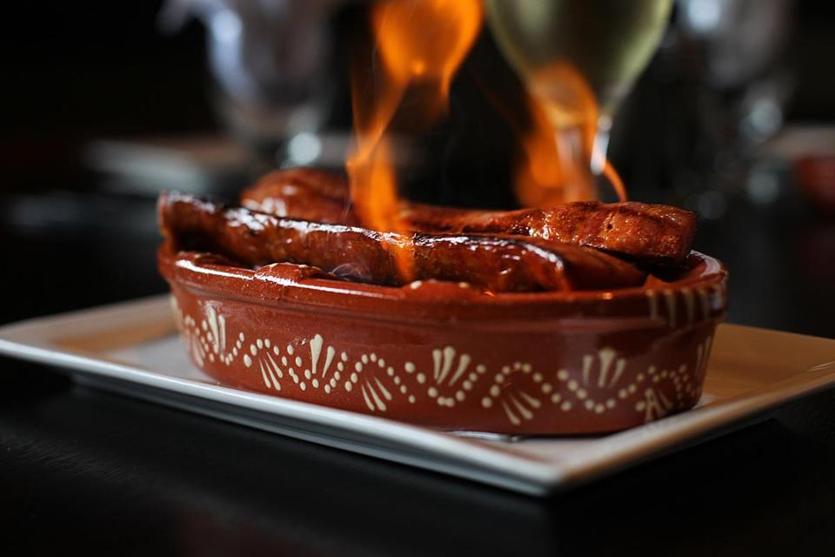
In winter, since it was difficult to go out to sea in search of fish, normally abundant, pork was often the main food. The cozinhada de porco is a witness of those times: the pickled pork, after being soaked in water, is cooked and served with potatoes and cabbage. Yam with linguiça (local sausage) and watercress soup are part of the traditional Flores menu. The cheese produced on the island has a soft and consistent texture. The sea is generous, and stimulates the culinary imagination of the inhabitants of Flores Island. In tortas de erva patinha the omelette is flavored with seaweed collected by the sea. The fish, which is part of the traditional gastronomic heritage of the island, is prepared according to various recipes: try the baked albacore (or yellowfin tuna), or conger-flavored warmirada.
The microclimate of certain areas allows the growth of exotic fruits. From the araçã, a plant of the goyaba family, yellow, red or violet fruits are harvested with which a typical aces compote is produced. Flores honey has the aroma of the infinite flowers that embellish the island.








